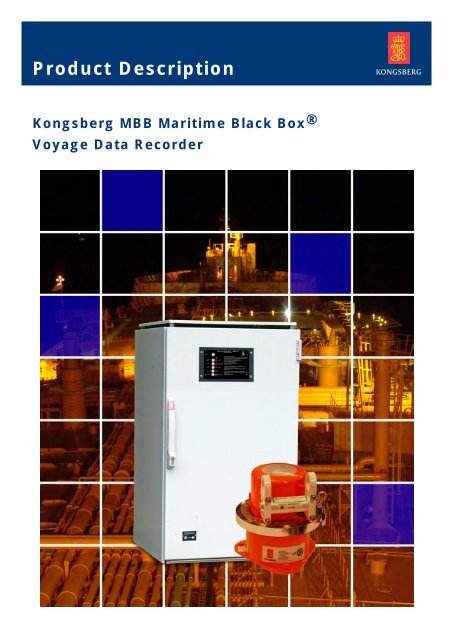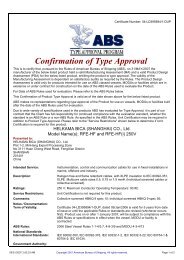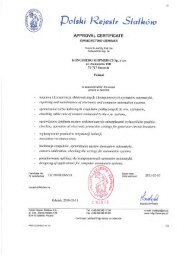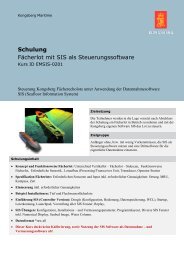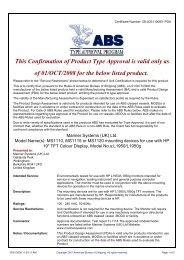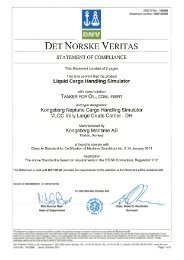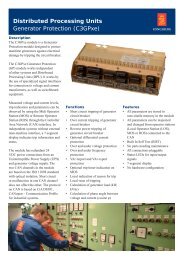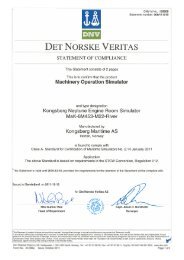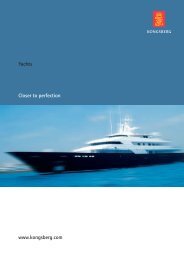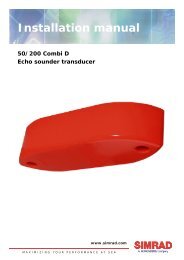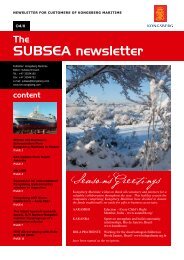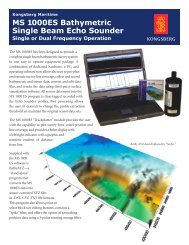Voyage data recorder - Kongsberg Maritime
Voyage data recorder - Kongsberg Maritime
Voyage data recorder - Kongsberg Maritime
Create successful ePaper yourself
Turn your PDF publications into a flip-book with our unique Google optimized e-Paper software.
Product Description<br />
<strong>Kongsberg</strong> MBB <strong>Maritime</strong> Black Box ®<br />
<strong>Voyage</strong> Data Recorder
<strong>Kongsberg</strong> MBB<br />
<strong>Maritime</strong> Black Box<br />
Product Description<br />
315077/A<br />
November 2008
Document history<br />
Document number: 315077<br />
Rev. A November 2008 First issue.<br />
Note<br />
The information contained in this document remains the sole property of <strong>Kongsberg</strong> <strong>Maritime</strong> AS. No<br />
part of this document may be copied or reproduced in any form or by any means, and the information<br />
contained within it is not to be communicated to a third party, without the prior written consent of<br />
<strong>Kongsberg</strong> <strong>Maritime</strong> AS.<br />
<strong>Kongsberg</strong> <strong>Maritime</strong> AS endeavours to ensure that all information in this document is correct and fairly<br />
stated, but does not accept liability for any errors or omissions.
Product Description<br />
Table of contents<br />
Glossary....................................................................................................................4<br />
SYSTEM OVERVIEW .......................................................... 5<br />
Experience ................................................................................................................5<br />
Key features..............................................................................................................6<br />
Common technology ................................................................................................6<br />
Integration of 3rd party applications ........................................................................6<br />
UNIT DESCRIPTIONS ........................................................ 8<br />
Overview ..................................................................................................................8<br />
Data Collection Unit (DCU)...................................................................................10<br />
Microphone Units (MU).........................................................................................12<br />
Uninterruptible Power Supply (UPS).....................................................................12<br />
Protected Storage Unit (PSU).................................................................................13<br />
Replay and Evaluation Unit (REU)........................................................................13<br />
MBB INTERFACES............................................................ 14<br />
TECHNICAL SPECIFICATIONS ......................................... 16<br />
Conformance with normative requirements ...........................................................16<br />
Supported interfaces ...............................................................................................16<br />
Data recorded .........................................................................................................16<br />
Recording frequencies............................................................................................18<br />
Features ..................................................................................................................18<br />
Other benefits .........................................................................................................18<br />
315077/A 3
<strong>Kongsberg</strong> MBB<br />
Glossary<br />
DCU<br />
Data Collection Unit<br />
GPS<br />
Global Positioning System<br />
EMC<br />
Electromagnetic Compatibility<br />
IEC<br />
International Electrotechnical Commission<br />
IMO<br />
International <strong>Maritime</strong> Organization<br />
I/O<br />
Input/Output<br />
LAN<br />
Local Area Network<br />
MBB ® <strong>Maritime</strong> Black Box ®<br />
PSU<br />
Protected Storage Unit<br />
REU<br />
Replay and Evaluation Unit<br />
SOLAS<br />
International Convention for the Safety of Life at Sea<br />
UPS<br />
Uninterruptible Power Supply<br />
VDR<br />
<strong>Voyage</strong> Data Recorder<br />
VHF<br />
Very High Frequency<br />
4 315077/A
System overview<br />
SYSTEM OVERVIEW<br />
Experience<br />
<strong>Kongsberg</strong> <strong>Maritime</strong> is one of the world’s largest suppliers<br />
of advanced marine electronics, with more than 30 years of<br />
experience with marine automation interfacing. We manufacture<br />
advanced navigation systems, marine automation, cargo<br />
management, safety systems and maritime simulators for the<br />
merchant marine, as well as dynamic positioning and control<br />
systems for offshore and research vessels. We have used this<br />
unique experience to provide a highly adaptable VDR system that<br />
is easily interfaced and installed on both existing and new vessels.<br />
The <strong>Kongsberg</strong> <strong>Maritime</strong> <strong>Maritime</strong> Black Box® <strong>Voyage</strong> Data<br />
Recorder (VDR) is designed to meet or exceed the requirements<br />
specified in SOLAS V, IMO A.861 and the performance standard<br />
given by IEC 61996.<br />
315077/A 5
<strong>Kongsberg</strong> MBB<br />
The main purpose of our <strong>Voyage</strong> Data Recorder is to record<br />
and store relevant ship’s <strong>data</strong>, and to allow reconstruction of<br />
ship incidents at sea. Our <strong>Voyage</strong> Data Recorder can be used to<br />
identify the cause of an incident, and in this way make a major<br />
contribution to increase operational safety at sea.<br />
Key features<br />
The <strong>Maritime</strong> Black Box is entirely automatic in normal<br />
operation. If the recording stops or <strong>data</strong> recorded is outside<br />
specified <strong>data</strong> range, the operator is alarmed through the local<br />
Operator Panel.<br />
The <strong>Maritime</strong> Black Box has a modular design for easy<br />
installation. Each module complies with the environmental<br />
requirements as specified in IEC 60945, including the<br />
requirements for radiated emission (EMC), and can be freely<br />
installed anywhere without causing disturbance to existing<br />
equipment.<br />
Common technology<br />
The use of common technology in the <strong>Kongsberg</strong> portfolio<br />
has allowed us to develop modular products. The benefits of<br />
modularity are passed on to our customers through:<br />
• Free flow of information between the <strong>Maritime</strong> Black Box<br />
and the K-range systems<br />
• Well-proven solutions that focus on the complete vessel<br />
operation<br />
• Operational consistency<br />
• Reduced spare parts and training requirements<br />
All K-range workstations share navigation and sensor <strong>data</strong><br />
through the Local Area Network, giving improved safety and<br />
easy operation. The <strong>Maritime</strong> Black Box utilises this for:<br />
• Recording of radar pictures every 15 second<br />
• Recording of navigation sensors and conning information<br />
display every second (K-Bridge only)<br />
• Recording of automation parameters and alarms every second<br />
(K-Chief only)<br />
Integration of 3rd party applications<br />
3rd party applications and sensors can be interfaced via serial<br />
lines or analogue/digital signals. All standard interface NMEA<br />
0183 protocols are supported, as well as a range of proprietary<br />
protocols.<br />
6 315077/A
System overview<br />
The <strong>Maritime</strong> Black Box requires a buffered audio output on<br />
the VHF unit and a buffered RGB output on the radar display<br />
unit. Amplifiers are used if signals are weak. These are usually<br />
supplied by the VHF/radar maker.<br />
Required <strong>data</strong> from 3rd party should be available on a form as<br />
stated by IEC 61996. If not, the <strong>data</strong> will only be recorded if<br />
specially agreed.<br />
315077/A 7
<strong>Kongsberg</strong> MBB<br />
UNIT DESCRIPTIONS<br />
Overview<br />
Our <strong>Voyage</strong> Data Recorder consists of the following units:<br />
• Data Collection Unit<br />
– The Data Collection Unit (DCU) is interfaced with ship’s<br />
equipment to collect, process and store all relevant ship’s<br />
<strong>data</strong> for a period of 12 hours, as required by IMO A.861.<br />
• Microphone Units<br />
– The microphones are used for recording of bridge audio,<br />
meeting the audio quality requirements as described in IEC<br />
61996.<br />
• Uninterruptible Power Supply<br />
– The Uninterruptible Power Supply (UPS) is connected<br />
to the ship’s emergency power supply, with a battery<br />
package providing more than the required 2 hours of audio<br />
recording during a black-out.<br />
• Protected Storage Unit<br />
– The Protected Storage Unit (PSU) stores <strong>data</strong> received<br />
from the DCU on a solid state recording medium. The PSU<br />
is calamity resistant by means of a protective capsule. It<br />
is located on top of the ship’s superstructure in order to<br />
provide easy recovery following an incident.<br />
• Replay and Evaluation Unit (option)<br />
– The Replay and Evaluation Unit (REU) is used to replay<br />
and evaluate previously recorded time synchronized voyage<br />
<strong>data</strong>. The REU is in addition an excellent tool for training<br />
purposes. Data stored in the PSU can be downloaded<br />
through the DCU for replay or long-term storage of <strong>data</strong>.<br />
8 315077/A
Unit descriptions<br />
315077/A 9
<strong>Kongsberg</strong> MBB<br />
Data Collection Unit (DCU)<br />
The Data Collection Unit (DCU) interfaces, records and<br />
processes <strong>data</strong> from all relevant ship’s equipment through<br />
interfacing sensors, equipment, microphones and radars. The<br />
DCU sends the recorded <strong>data</strong> to the Protected Storage Unit<br />
(PSU) for storage.<br />
The DCU consists of the following main modules:<br />
• A computer (PC) for recording, processing and storing of<br />
<strong>data</strong> in the PSU.<br />
• An audio recording interface for processing of VHF and<br />
voice communication on the Bridge. It has 12 input channels<br />
for microphone and radio signals. The <strong>Kongsberg</strong> standard<br />
delivery includes two channels for VHF and four for<br />
microphones.<br />
• A serial interface providing input for 12 serial lines (NMEA<br />
0183 or RS-422).<br />
• An optional interface with 16 channels for analogue or digital<br />
signals.<br />
• A front mounted Operator Panel for monitoring and operation.<br />
The PC and interfacing modules are located inside the DCU<br />
cabinet. All interfacing modules are approved according to E10<br />
and IEC 60945, allowing flexible mounting, even directly on<br />
rotating equipment.<br />
The DCU is supplied in a standard cabinet. However, all modules<br />
making the DCU are separately type approved. This allows<br />
flexible delivery of the system, and not limited to the cabinet<br />
described above.<br />
External cables are pulled to relevant connection terminals<br />
through the bottom of the cabinet.<br />
Computer (PC)<br />
The PC can hold <strong>data</strong> for more than 30 days using a standard 120<br />
GByte hard disk. Radar signals are connected directly to the PC<br />
– for the <strong>Kongsberg</strong> K-Bridge through a LAN connection, for<br />
other radars through a dedicated frame grabber card mounted<br />
inside the PC.<br />
This standard industrial PC is also used by the <strong>Kongsberg</strong><br />
DataChief® C20 and K-Chief 500 alarm, monitoring and control<br />
system, where functionality and reliability has been proven<br />
through deliveries of thousands of units to ships worldwide.<br />
10 315077/A
Unit descriptions<br />
Operator Panel<br />
The user interaction with the MBB system is very limited.<br />
Operation and alarm functions are provided through the Operator<br />
Panel. The panel provides easy operation of system status and<br />
all mandatory alarms. The panel is mounted into the front of the<br />
DCU, but may also be wall mounted or mounted into existing<br />
consoles.<br />
Audio recording process<br />
An internal audio recording module interfaces VHF and<br />
microphones, and records these audio signals. The module<br />
has 12 channels for interfacing to microphones and VHF sets.<br />
The audio channels can be used in any configuration, but the<br />
standard supply is two channels for VHF communication and<br />
four channels for bridge microphones.<br />
Audio signals from the different channels are sent directly to<br />
the PC through a USB interface, where the audio recording<br />
application modulates the signals prior to storing the <strong>data</strong> in the<br />
PSU.<br />
Radar images<br />
Radar images are recorded using two different methods:<br />
• An internal radar <strong>recorder</strong> – used when <strong>Kongsberg</strong>’s K-Bridge<br />
navigation system is present.<br />
• A dedicated frame grabber card – used to record images from<br />
3rd party radar suppliers.<br />
Radar images from the K-Bridge system are recorded using a<br />
print screen function that creates a snapshot of the currently<br />
presented radar screen. The snapshots are then sent to the PC<br />
through a LAN interface.<br />
315077/A 11
<strong>Kongsberg</strong> MBB<br />
Radar images from 3rd party radar suppliers are recorded by<br />
interfacing the monitor that presents information to the operator.<br />
Serial interfaces<br />
An internal module interfaces ship information available on<br />
serial lines. This module has 12 channels for interfacing serial<br />
NMEA 0183 or RS–422 signals, and one dedicated channel for<br />
sending MBB status information to 3rd parties.<br />
Analogue/digital interfaces<br />
Dedicated modules can be used for interfacing analogue and<br />
digital signals from ship’s equipment. If required, the DCU<br />
cabinet will be supplied with one such module, making 16 signals<br />
available for interfacing to analogue or digital sources. However,<br />
a practically unlimited number of modules can be supplied for<br />
interfacing, but this must be evaluated and quoted in each project.<br />
Microphone Units (MU)<br />
The microphones are used for recording of bridge audio. Four<br />
microphones for installation on the bridge ceiling are supplied<br />
as standard.<br />
To verify microphone functionality, each microphone is equipped<br />
with a speaker for testing of microphone reception. The speaker<br />
gives a non-abusive signal every 12 hours. This signal is<br />
detected by the PC, hence verifying the operational status of the<br />
microphones.<br />
All metal surfaces are coated with satin black powder paint.<br />
Uninterruptible Power Supply (UPS)<br />
The Uninterruptible Power Supply (UPS) shall be connected to<br />
the ship’s emergency power supply.<br />
Its main function is to maintains a continuous supply of electric<br />
power to the MBB system when ship’s power is not available,<br />
but the UPS also protects MBB components against voltage and<br />
frequency fluctuations.<br />
Basic power control functions are accessible on the front panel<br />
of the UPS.<br />
12 315077/A
Unit descriptions<br />
Protected Storage Unit (PSU)<br />
The Protected Storage Unit (PSU) is a fully IMO compliant<br />
final recording medium. It also complies with all relevant IEC<br />
requirements.<br />
Its solid-state <strong>recorder</strong> utilises proven aircraft technology to<br />
provide storage capacity exceeding 12 hours of radar, sensor and<br />
audio <strong>data</strong>. The final recording medium is stored in a protective<br />
capsule within the PSU.<br />
An underwater locator beacon is fitted to aid in locating the<br />
<strong>recorder</strong> in the event of a catastrophic incident. The PSU will<br />
preferably be located on top of the bridge so as to maximise the<br />
probability of its survival and recovery following an incident.<br />
The unit is equipped with a quick release mechanism for easy<br />
recovery.<br />
The PSU is designed to survive extreme environmental<br />
conditions:<br />
• Shock: 11 millisecond duration of 50 g<br />
• Penetration: 3 metres, 250 kg drop test<br />
• Fire: 1100 ºC for 1 hour, 260 ºC for 10 hours<br />
• Deep sea immersion: 30 days at 6,000 metres depth<br />
Replay and Evaluation Unit (REU)<br />
The Replay and Evaluation Unit (REU) is used to replay and<br />
evaluate previously recorded time synchronized voyage <strong>data</strong>.<br />
REU software is always included in the MBB delivery, but the<br />
REU hardware is not included in the standard scope of supply.<br />
However, for training purposes it is recommended to include the<br />
REU in the installation.<br />
The REU can replay <strong>data</strong> that is downloaded from the PSU or<br />
recorded in parallel, as <strong>data</strong> sent to the PSU is stored directly on<br />
the REU’s hard disk. This avoids interruption of the recording<br />
process for <strong>data</strong> download. Audio, radar and other parameters<br />
recorded can be replayed co-ordinated or separately, providing<br />
flexibility for evaluation of the recorded <strong>data</strong>.<br />
The REU can also be used to provide on-line <strong>data</strong> from the<br />
MBB system to other systems, such as <strong>Kongsberg</strong>’s Electronic<br />
Logbooks (K-Log), <strong>Kongsberg</strong>’s FleetMaster information<br />
management system or other ship administrative applications.<br />
315077/A 13
<strong>Kongsberg</strong> MBB<br />
MBB INTERFACES<br />
An essential part of the MBB is to interface the various sensors<br />
that provide the operational information to be recorded. There are<br />
many possible solutions, depending on the types of equipment<br />
on-board for navigation, propulsion control, alarm monitoring<br />
and control, process control and so on.<br />
The figure below illustrates a situation where the ship has a fully<br />
integrated system from <strong>Kongsberg</strong> <strong>Maritime</strong>. In this case all<br />
the parameters and the radar image can be retrieved from these<br />
systems.<br />
14 315077/A
MBB interfaces<br />
The other extreme is illustrated by the figure below, where<br />
none of the systems providing <strong>data</strong> are supplied by <strong>Kongsberg</strong><br />
<strong>Maritime</strong>. In this case each individual <strong>data</strong> source must be<br />
identified, with physical connection points, <strong>data</strong> formats,<br />
estimated <strong>data</strong> quality etc.<br />
Data items<br />
The table summarises how related <strong>Kongsberg</strong> <strong>Maritime</strong> systems<br />
on-board can be used as <strong>data</strong> sources for the MBB versus 3rd<br />
party systems. General purpose interface modules are provided<br />
to interface 3rd party signals.<br />
<strong>Kongsberg</strong> <strong>Maritime</strong><br />
system<br />
Interface type<br />
3rd party interface<br />
type<br />
Radar K-Bridge LAN Frame grabber<br />
VHF audio MBB Analogue Analogue<br />
Bridge audio MBB Analogue N/A<br />
Position K-Bridge LAN Serial or I/O<br />
Speed K-Bridge LAN Serial or I/O<br />
Time & date K-Bridge LAN Serial or I/O<br />
Heading K-Bridge LAN Serial or I/O<br />
Depth K-Bridge LAN Serial or I/O<br />
Main alarms K-Chief LAN Serial or I/O<br />
Rudder order &<br />
response<br />
Engine order &<br />
response<br />
K-Bridge/K-Chief LAN Serial<br />
AutoChief LAN Serial or I/O<br />
Hull openings K-Chief LAN Serial or I/O<br />
Water tight and fire<br />
doors<br />
Accelerations and hull<br />
stress<br />
K-Chief LAN Serial or I/O<br />
K-Chief LAN Serial<br />
Wind speed & direction K-Bridge LAN Serial or I/O<br />
Fire alarms K-Chief LAN Serial or I/O<br />
315077/A 15
<strong>Kongsberg</strong> MBB<br />
TECHNICAL SPECIFICATIONS<br />
Conformance with normative requirements<br />
The <strong>Maritime</strong> Black Box system is designed to conform to the<br />
normative requirements described in the table below.<br />
Description<br />
References<br />
DCU functionality IEC 61996<br />
DCU environmental IEC 60945<br />
Audio quality IEC 60268-16<br />
Radar recording quality IEC 61996<br />
PSU environmental IEC 60945<br />
PSU survivability IEC 61996<br />
REU functionality (see note) IEC 61996<br />
Type approval<br />
Note<br />
Det Norske Veritas (DNV)<br />
The REU is not a part of the VDR according to IEC 61996<br />
specification, however to meet the functional requirements a<br />
replay unit must be available for investigation after accidents.<br />
Supported interfaces<br />
Data recorded<br />
• Local area connection (LAN) to <strong>Kongsberg</strong> <strong>Maritime</strong>’s<br />
systems, including navigation and automation<br />
• Up to twelve serial lines supporting RS-422, NMEA 0183<br />
Protocol<br />
• Analogue 0-10 V, 4-20 mA, digital signals, pulse and sync<br />
signals<br />
• RGB VESA video signals<br />
Video<br />
Parameter<br />
Radar<br />
Description<br />
Radar image as displayed to the operator. An<br />
interface to radar is included in the standard<br />
delivery.<br />
16 315077/A
Technical specifications<br />
Audio<br />
Parameter<br />
Bridge audio<br />
Communication audio<br />
(VHF)<br />
Parameters (other <strong>data</strong>)<br />
Parameter<br />
Data and time<br />
Ship position<br />
Ship speed<br />
Ship heading<br />
Echo sounder<br />
Rudder order and<br />
response<br />
Engine order and<br />
response<br />
Main alarms (IMO<br />
mandatory alarms on the<br />
bridge)<br />
Accelerations and hull<br />
stresses<br />
Wind speed and direction<br />
Hull openings status<br />
Watertight and fire door<br />
status<br />
Description<br />
Bridge audio is recorded through microphones<br />
located on the bridge. Four microphones are<br />
included in the standard delivery.<br />
In- and outbound communication from the<br />
ship’s VHF. An interface to VHF is included in<br />
the standard delivery.<br />
Description<br />
Date and time is derived from a device external<br />
from the ship, normally a GPS.<br />
Latitude and longitude is derived from an<br />
electronic position-fixing system (GPS).<br />
Ship speed is normally recorded from the<br />
ships’ Speed Log.<br />
Ship heading is recorded as indicated by the<br />
ship’s compass or gyrocompass.<br />
This includes depth under keel, the depth scale<br />
currently being displayed and other status<br />
information if available.<br />
Rudder order and response angle on rudder<br />
is recorded, including status and setting of<br />
autopilot if fitted.<br />
Including position of engine telegraphs, both<br />
ordered speed and propeller response. Bow<br />
and stern thrusters are also recorded if fitted.<br />
Including the status of all mandatory alarms on<br />
the bridge, more specifications in the preceding<br />
paragraph.<br />
Where a ship is fitted with hull stress and<br />
response monitoring equipment all the <strong>data</strong><br />
items that have been pre-selected within that<br />
equipment is recorded.<br />
The wind speed and direction is recorded from<br />
the navigation system. Both true and relative<br />
wind is recorded, including each direction.<br />
Including all IMO mandatory status<br />
information of hull openings that’s required to<br />
be displayed on the bridge.<br />
This includes all IMO mandatory status<br />
information that’s required to be displayed on<br />
the bridge.<br />
315077/A 17
<strong>Kongsberg</strong> MBB<br />
Recording frequencies<br />
Audio<br />
Audio are recorded continuously, where bridge audio are<br />
recorded with 12 kHz and VHF audio with 8 kHz bandwidth.<br />
Radar<br />
Radar image is recorded with a frequency of one per 15 seconds.<br />
Parameters<br />
Parameters are a common name of all other <strong>data</strong> recorded than<br />
audio and radar, and are recorded with a frequency of 1 Hz.<br />
Features<br />
• Fully compliant with IEC 61996 (Shipborne <strong>Voyage</strong> Data<br />
Recorder)<br />
• Availability of wide range of interfacing modules<br />
• Two hours uninterruptible power supply<br />
• Twelve hours of cumulative <strong>data</strong> storage capacity<br />
• On-board playback of recorded <strong>data</strong><br />
• Optional interface with the ship’s administrative network<br />
• Parallel recording on hard disk (30 days)<br />
Other benefits<br />
• Recorded VDR <strong>data</strong> is primarily intended for incident<br />
analysis. However, since the MBB contains essential ship’s<br />
<strong>data</strong>, this can also be made available for:<br />
• Electronic logbooks<br />
• Vessel maintenance<br />
• On-board training<br />
• Reporting and trending<br />
• Vessel routing<br />
• Weather and hydrographic <strong>data</strong> collection<br />
18 315077/A
Technical specifications<br />
315077/A 19
©2008 <strong>Kongsberg</strong> <strong>Maritime</strong>


